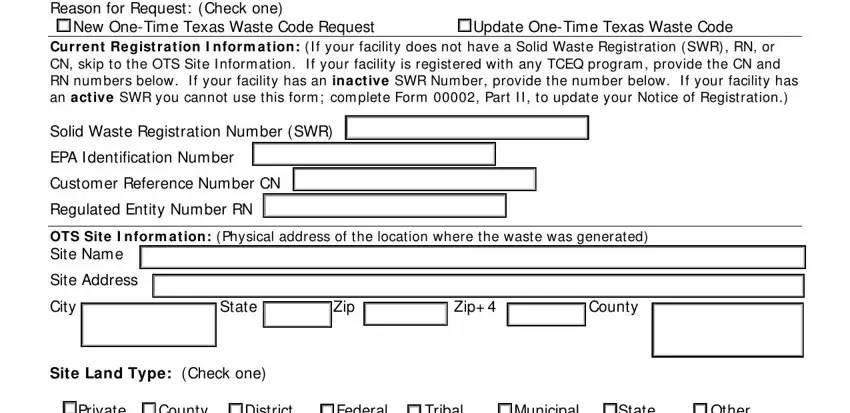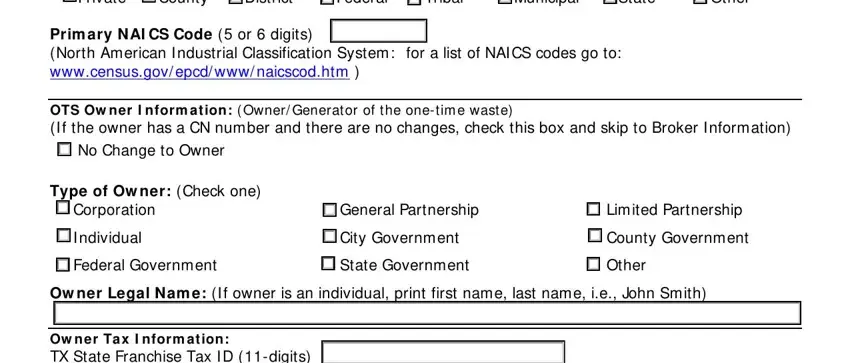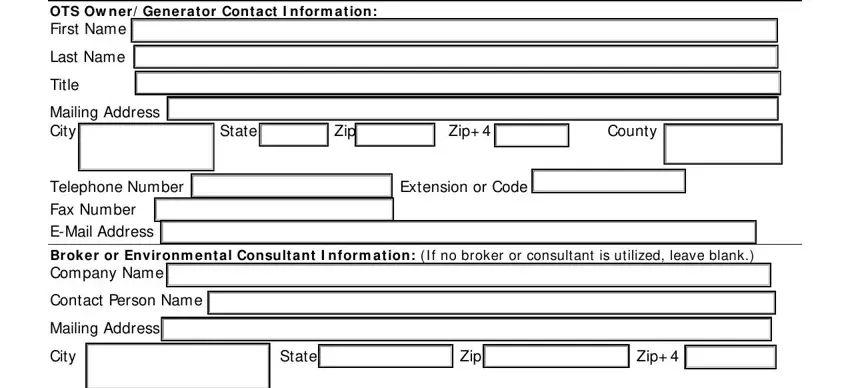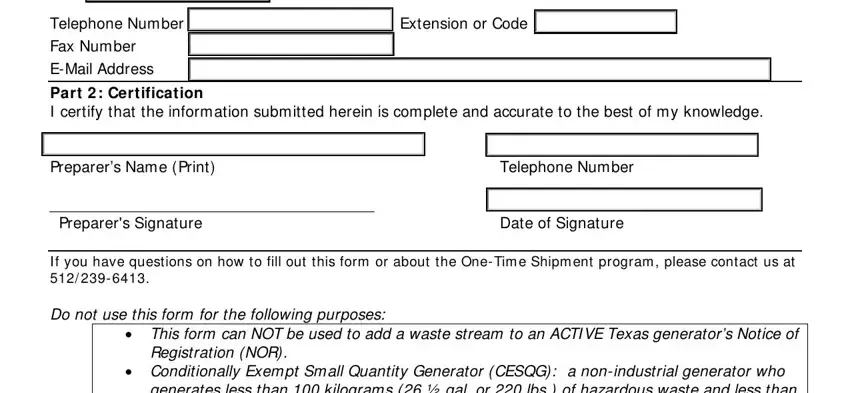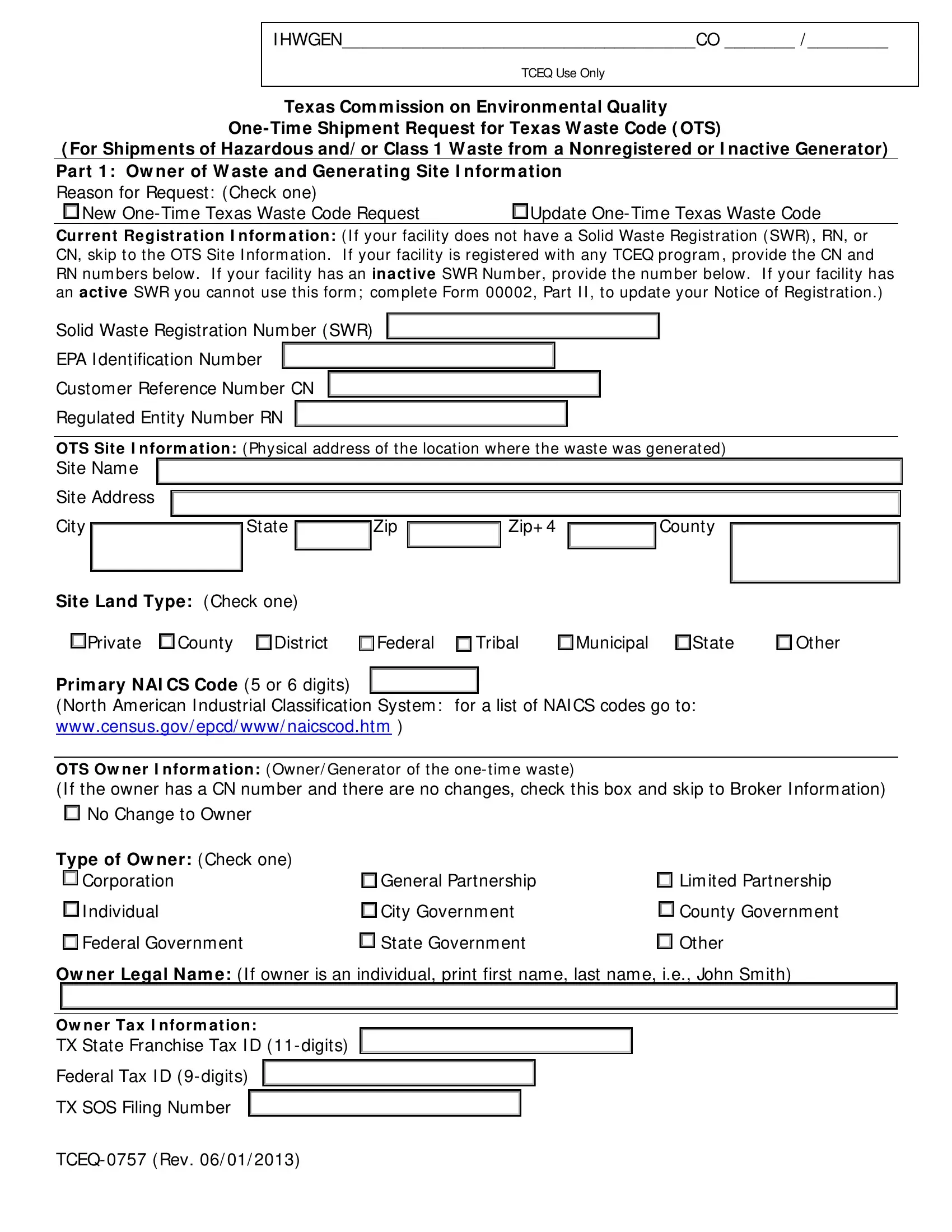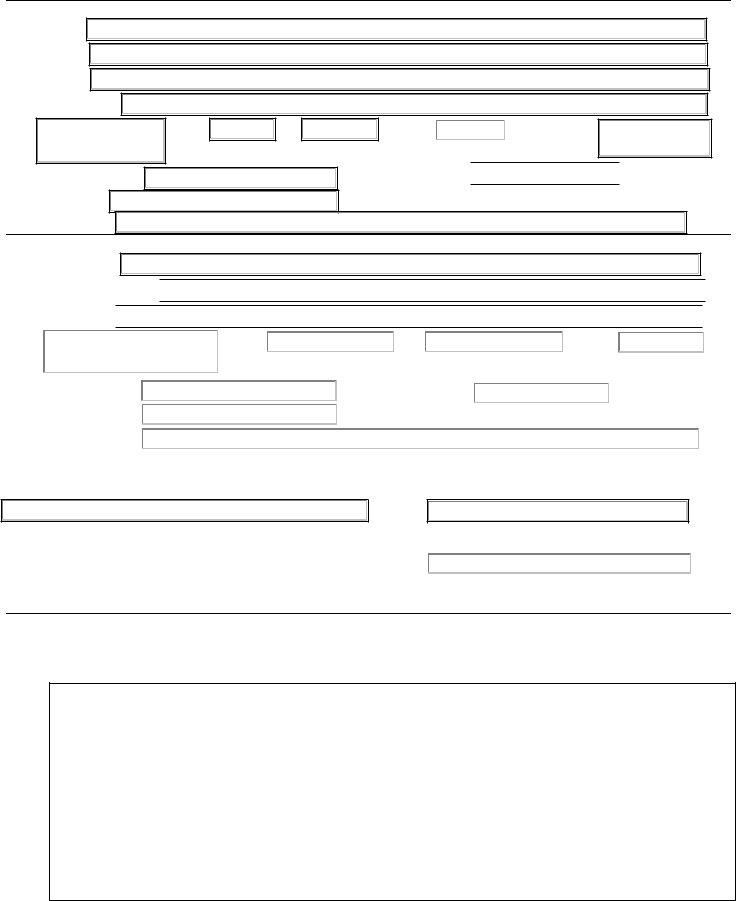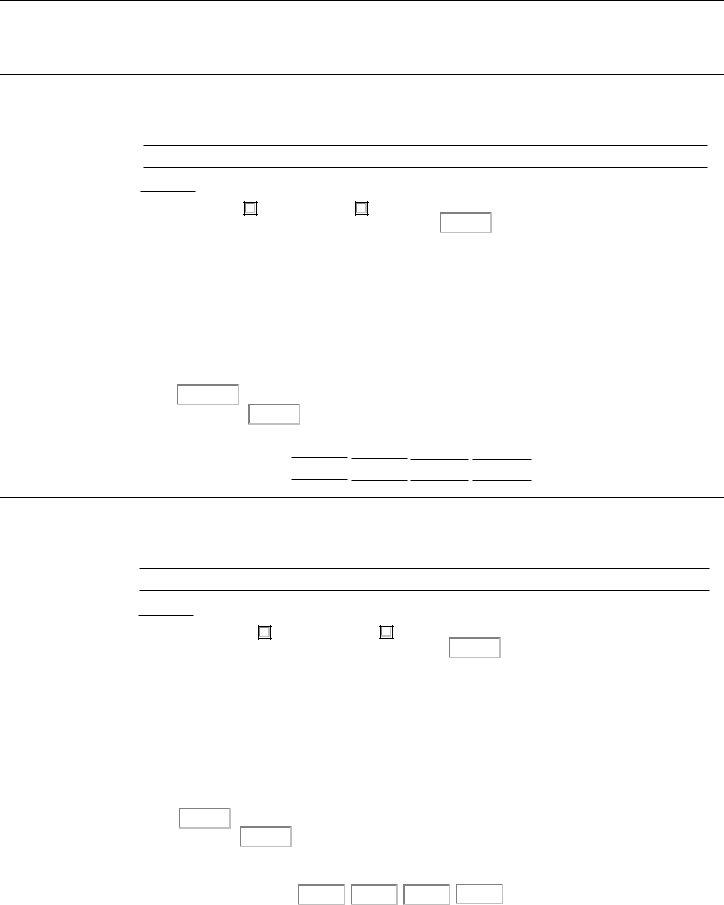
I HWGEN___________________________________CO _______ / ________
TCEQ Use Only
Texas Com m ission on Environm ental Quality
One- Tim e Shipm ent Request for Texas W aste Code ( OTS)
( For Shipm ents of Hazardous and/ or Class 1 W aste from a Nonregistered or I nactive Generator)
Part 1 : Ow ner of W aste and Generating Site I nform ation
Reason for Request: (Check one) |
|
New One-Time Texas Waste Code Request |
Update One- Time Texas Waste Code |
Current Regist rat ion I nform at ion: ( I f your facility does not have a Solid Wast e Regist ration (SWR) , RN, or CN, skip t o the OTS Sit e I nform ation. I f your facility is regist ered with any TCEQ program , provide the CN and RN num bers below. I f your facility has an inact ive SWR Num ber, provide t he num ber below. I f your facility has an act ive SWR you cannot use this form ; com plet e Form 00002, Part I I , t o updat e your Notice of Regist ration.)
Solid Waste Registration Number (SWR)
EPA I dentification Number
Customer Reference Number CN
Regulated Entity Number RN
OTS Site I nform at ion: (Physical address of t he location where the wast e was generat ed)
Site Name
Site Address
City
Site Land Type: (Check one) |
|
|
|
|
|
Private |
County |
District |
Federal |
Tribal |
Municipal |
State |
Other |
Prim ary NAI CS Code (5 or 6 digits)
(North American I ndustrial Classification System : for a list of NAICS codes go to: www.census.gov/ epcd/ www/ naicscod.htm )
OTS Ow ner I nform at ion: ( Owner/ Generat or of t he one- tim e wast e)
(I f the owner has a CN number and there are no changes, check this box and skip to Broker Information) No Change to Owner
Type of Ow ner: (Check one) |
|
Corporation |
General Partnership |
I ndividual |
City Government |
Federal Government |
State Government |
Lim ited Partnership
County Government
Other
Ow ner Legal Nam e: (I f owner is an individual, print first name, last name, i.e., John Smith)
Ow ner Tax I nform at ion:
TX State Franchise Tax I D (11- digits)
Federal Tax I D (9- digits)
TX SOS Filing Number
TCEQ- 0757 (Rev. 06/ 01/ 2013)
One-Time Shipment Request for Texas Waste Code Page 2
OTS Ow ner/ Generator Cont act I nform at ion:
First Name
Last Name
Title
Mailing Address |
|
|
City |
State |
Zip |
Telephone Number
Fax Number
E-Mail Address
Brok er or Environm ent al Consult ant I nform at ion: ( I f no broker or consultant is utilized, leave blank.)
Company Name
Contact Person Name Mailing Address
City |
|
|
State |
|
|
Zip |
|
|
Zip+ 4 |
|
|
|
|
|
|
|
|
|
|
|
|
|
|
|
|
|
|
|
|
|
|
|
|
|
|
|
|
|
|
|
|
|
|
|
|
|
|
|
|
|
|
Telephone Number |
|
|
|
Extension or Code |
|
|
|
|
|
|
Fax Number |
|
|
|
|
|
|
|
|
|
|
|
|
|
|
|
|
|
|
|
|
|
|
|
|
|
E-Mail Address |
|
|
|
|
|
|
|
|
|
|
|
|
|
|
|
|
|
|
|
|
|
|
|
|
|
|
Part 2 : Certification
I certify that the information submitted herein is complete and accurate to the best of my knowledge.
Preparer’s Name (Print) |
Telephone Number |
____________________________________ |
|
|
Preparer's Signature |
Date of Signature |
I f you have questions on how t o fill out this form or about the One- Tim e Shipm ent program , please contact us at 512/ 239- 6413.
Do not use this form for the following purposes:
•This form can NOT be used to add a waste stream to an ACTI VE Texas generator’s Notice of Registration (NOR) .
•Conditionally Exem pt Sm all Quantity Generator (CESQG): a non- industrial generator who generates less than 100 kilograms (26 ½ gal. or 220 lbs.) of hazardous waste and less than 1 kilogram (about 1 quart) of acutely hazardous waste in any calendar m onth (30 Texas Adm inistrative Code (TAC) 335.78) . These generators do not have a notification or reporting requirem ent and should m anifest their waste using the following inform ation:
O Solid Waste Registration Num ber – CESQG O EPA I dentification Num ber – TXCESQG
O Sequence Num ber of waste stream – CESQ + form code + class code (H or 1)
•Non- industrial non- hazardous generators should not use this form . See above inform ation for CESQG.
TCEQ- 0757 (Rev. 06/ 01/ 2013)
One-Time Shipment Request for Texas Waste Code
Page 3
Part 3 : W aste Code I nform ation
Submit Waste Code I nformation (questions 1- 7) for each Texas Waste Code needed. Copy this page to request more than 2 Texas Waste Codes. The information needed to complete Part 3 can be found in the I nstructions for TCEQ Form 0757.
W aste Code 1 :
1.W aste Description: The description should include: What the waste is and how it was
generated. (Exam ple: Spent solvent from degreasing operation in tool production. Waste is a
m ixture of m ineral spirits and m etal shavings.)
Description:
2.Form Code: (For a list of Form Codes, see Appendix A)
3. |
Class Code: (Check one) |
|
Hazardous |
Class 1 |
|
|
|
|
4. |
Origin Code: (Choose one code from the table below): |
|
|
|
|
|
|
|
|
|
|
|
|
|
|
|
|
CODE |
|
PROCESS/ ACTI VI TY |
|
|
|
|
1 |
|
Generated on-site from a product process or service activity. |
|
2 |
|
Spill clean- up, equipment decommissioning, or emergency removal by company. |
|
3 |
|
Derived from the on- site management of a non- hazardous waste. |
|
4 |
|
Waste received from off- site and not recycled or treated on- site. |
|
5 |
|
Residual from on-site treatment, disposal or recycling of hazardous waste. |
|
6 |
|
State, federal or locally funded cleanup. |
|
7 |
|
Corrective action or closure. |
|
|
|
5. |
|
Source Code: G |
|
(For a list of Source Codes, see Appendix B) |
6. |
|
|
|
|
|
|
|
|
System Type Code: H |
|
|
|
|
|
|
|
|
|
selected Source Code G25. |
|
(Only fill out System Type Code if you |
|
For a list of System Type Codes, see Appendix C.) |
7.EPA Hazardous W aste Num ber: (For a list of EPA hazardous waste numbers, see 40 (CFR) Code of Federal Regulations, Part 261, Subpart C at www.epa.gov) .
W aste Code 2 :
1.W aste Description: The description should include: What the waste is and how it was
generated. (Exam ple: Spent solvent from degreasing operation in tool production. Waste is a
m ixture of m ineral spirits and m etal shavings.)
Description:
2.Form Code: (For a list of Form Codes, see Appendix A)
|
|
|
|
|
|
|
|
|
|
|
|
|
|
|
|
|
|
|
|
3. |
Class Code: (Check one) |
|
Hazardous |
Class 1 |
|
|
|
|
4. |
Origin Code: (Choose one code from the table below): |
|
|
|
|
|
|
CODE |
|
PROCESS/ ACTI VI TY |
|
|
|
|
|
|
|
|
|
1 |
|
Generated on-site from a product process or service activity. |
|
|
2 |
|
Spill clean- up, equipment decommissioning, or emergency removal by company. |
|
|
3 |
|
Derived from the on- site management of a non- hazardous waste. |
|
|
4 |
|
Waste received from off- site and not recycled or treated on- site. |
|
|
5 |
|
Residual from on-site treatment, disposal or recycling of hazardous waste. |
|
|
6 |
|
State, federal or locally funded cleanup. |
|
|
|
|
|
|
|
|
|
7 |
|
Corrective action or closure. |
|
|
|
|
|
|
|
|
5. |
|
Source Code: G |
|
|
(For a list of Source Codes, see Appendix B) |
|
|
|
|
|
|
|
|
|
|
|
|
|
|
|
|
|
|
6. |
|
System Type Code: H |
|
|
|
|
|
|
|
|
|
|
|
|
|
|
|
|
|
|
|
|
|
|
|
|
|
|
|
(Only fill out System Type Code if you selected Source Code G25. |
|
For a list of System Type Codes, see Appendix C.) |
|
|
|
|
|
|
|
|
7. |
EPA Hazardous W aste Num ber: |
|
|
|
|
|
|
|
|
|
(For a list of EPA hazardous |
|
waste numbers, see 40 (CFR) Code of Federal Regulations, Part 261, Subpart C at www.epa.gov) . |
TCEQ- 0757 (Rev. 06/ 01/ 2013)
TCEQ One-Time Shipment Request for Texas Waste Code - Instructions
You may mail or fax this form . I f the form is faxed, do not m ail a copy. Due to the U.S. EPA Cromerr Rule, this form may not be submitted using email.
Fax: 512- 239- 6410 Phone: 512- 239- 6413
Mailing Address: Texas Commission on Environmental Quality, Perm itting and Remediation Support Division, Registration and Reporting Section, PO Box 13087 MC 129, Austin, Texas 78711- 3087
Reasons for expediting One- Tim e Shipm ent ( OTS) form s:
All reasons must be submitted in writing with this form .
Endangerment to human health or the environment.
Under a governmental order (i.e., Federal, State, County, etc.); copy of the order is required.
Financial duress: I f results are not received within a specific time, the company will suffer temporary/ permanent close of business, bankruptcy, layoff of personnel, etc.
APPENDI X A - FORM CODE LI ST: Texas Form Codes (This list has been modified for OTS. For a complete list, see Appendix A of the I nstructions for Notification for I ndustrial or Hazardous Waste Management, Form No. 00002.)
LAB PACKS—Lab packs of mixed wastes, chemicals, lab wastes
Code W aste Description
001Lab pack of old chemicals only
002Lab pack of debris only
003Mixed lab packs
004Lab pack containing acute hazardous wastes
009Other lab pack (Specify in Comments)
LI QUIDS—Inorganic and organic liquids
I norganic Liquids: Waste that is primarily inorganic and highly fluid (e.g., aqueous), with low suspended inorganic solids and low organic content
Code W aste Description
101Aqueous waste with low solvents
102Aqueous waste with low other toxic organic
103Spent acid with metals
104Spent acid without metals
105Acidic aqueous waste
106Caustic solution with m etals but no cyanides
107Caustic solution with m etals and cyanides
108Caustic solution with cyanides but no metals
109Spent caustic
110Caustic aqueous waste
111Aqueous waste with reactive sulfides
112Aqueous waste with other reactive (e.g., explosives)
113Other aqueous waste with high dissolved solids
114Other aqueous waste with low dissolved solids
115Scrubber water
116Leachate
117Waste liquid mercury
119 Other inorganic liquids (Specify in Comments)
198Nonhazardous photographic chemical wastes (inorganic)
199Brine solution that could also bear the form code 113
TCEQ Form 0757 - I nstructions
Page 2
Organic Liquids: Waste that is primarily organic and is highly fluid, with low inorganic solids content and low- to- moderate water content
Code W aste Description
201Concentrated solvent- water solution
202Halogenated (e.g., chlorinated) solvent
203Nonhalogenated solvent
204Halogenated/ nonhalogenated solvent mixture
205Oil- water emulsion or mixture
206Waste oil
207Concentrated aqueous solution of other organic
208Concentrated phenolics
209Organic paint, ink, lacquer, or varnish
210Adhesives or epoxies
211Paint thinner or petroleum distillates
212Reactive or polymerizable organic liquids
219Other organic liquids (specify in Comments)
296Ethylene glycol based antifreeze
297Nonhazardous liquids containing greater than or equal to ( ≥) 50 and less than (< ) 500 ppm PCBs
298Nonhazardous liquids containing greater than or equal to ( ≥) 500 ppm PCBs
299Nonhazardous photographic chemical waste (organic)
SOLIDS—I norganic or organic solids
I norganic Solids: Waste that is primarily inorganic and solid, with low organic content and low- to- moderate water content; not pumpable
Code W aste Description
301Soil contaminated with organic
302Soil contaminated with inorganics only
303Ash, slag, or other residue from incineration of wastes
304Other “dry” ash, slag, or thermal residue
305“Dry” lime or metal hydroxide solids, chemically “fixed”
306“Dry” lime or metal hydroxide solids, not “fixed”
307Metal scale, filings, or scrap
308Empty or crushed metal drums or containers
309Batteries or battery parts, casings, cores
310Spent solid filters or absorbents
311Asbestos solids and debris
312Metal- cyanide salts/ chemicals
313Reactive cyanide salts/ chemicals
314Reactive sulfide salts/ chemicals
315Other reactive salts/ chemicals
316Other metal salts/ chemicals
319Other waste inorganic solids (specify in Comments)
388Empty or crushed glass containers
389Nonhazardous sandblasting waste
390Nonhazardous concrete/ cement/ construction debris
391Nonhazardous dewatered wastewater treatment sludge
392Nonhazardous dewatered air pollution control device sludge
393Catalyst waste
394Nonhazardous solids containing greater than or equal to ( ≥) 50 ppm and less than (< ) 500 ppm PCBs
395Nonhazardous solids containing greater than or equal to ( ≥) 500 ppm PCBs
396Nonhazardous electrical equipment/ devices containing greater than or equal to ( ≥) 50 ppm and less than (< ) 500 ppm PCBs
397Nonhazardous electric equipment/ devices containing greater than or equal to ( ≥) 500 ppm PCBs
398Nonhazardous soils containing greater than or equal to ( ≥) 50 ppm or less than (< ) 500 ppm PCBs
399Nonhazardous soils containing greater than or equal to ( ≥) 500 ppm PCBs
Organic Solid: Waste that is primarily organic and solid, with low- to-moderate inorganic content and water content; not pumpable
Code W aste Description
401Halogenated pesticide solid
402Nonhalogenated pesticide solid
403Solids resins or polymerized organic
404Spent carbon
405Reactive organic solid
406Empty fiber or plastic containers
407Other halogenated organic solids (specify in Comments)
409Other nonhalogenated organic solids (specify in Comments)
488Wood debris
489Petroleum contaminated solids
490Sandblasting waste
491Dewatered biological treatment sludge
492Dewatered sewage or other untreated biological sludge
493Catalyst waste
494Solids containing greater than or equal to ( ≥) 50 ppm and less than (< ) 500 ppm PCBs
495Solids containing greater than or equal to ( ≥) 500 ppm PCBs
496Electrical equipment/ devices containing greater than or equal to ( ≥) 50 ppm and less than (< ) 500 ppm PCBs
497Electrical equipment/ devices containing greater than or equal to ( ≥) 500 ppm PCBs
498Soils containing greater than or equal to ( ≥) 50 ppm and less than (< ) 500 ppm PCBs
499Soils containing greater than or equal to ( ≥) 500 ppm PCBs
SLUDGE—I norganic or organic sludge
I norganic Sludge: Waste that is primarily inorganic, with moderate- to-high water content and low organic content and pumpable
Code W aste Description
501Lime sludge without metals
502Lime sludge with metals/ metal hydroxide sludge
503Wastewater treatment sludge with toxic organic
504Other wastewater treatment sludge
505Untreated plating sludge without cyanides
506Untreated plating sludge with cyanides
507Other sludge with cyanides
508Sludge with reactive sulfides
509Sludge with other reactive
510Degreasing sludge with metal scale or filings
511Air pollution control device sludge (e.g., fly ash, wet scrubber sludge)
512Sediment or lagoon dragout contaminated with organic
513Sediment or lagoon dragout contaminated with inorganics only
514Drilling mud
515Asbestos slurry or sludge
516Chloride or other brine sludge
519Other inorganic sludge (specify in Comments)
597Catalyst waste
598Nonhazardous sludge containing greater than or equal to ( ≥) 50 ppm and less than (< ) 500 ppm PCBs
599Nonhazardous sludge containing greater than or equal to ( ≥) 500 ppm PCBs
TCEQ Form 0757 - I nstructions
Page 4
Organic Sludge: Waste that is primarily organic with low- to- moderate inorganic solids content and water content, and pumpable
Code W aste Description
601Still bottoms of halogenated (e.g., chlorinated) solvents or other organic liquids
602Still bottoms of nonhalogenated solvents or other organic liquids
603Oily sludge
604Organic paint or ink sludge
605Reactive or polymerizable organic
606Resins, tars, or tarry sludge
607Biological treatment sludge
608Sewage or other untreated biological sludge
609Other organic sludge (specify in Comments)
695Petroleum -contaminated sludge other than still bottoms and oily sludge
696Grease
697Catalyst waste
698Nonhazardous sludge containing greater than or equal to ( ≥) 50 ppm and less than (< ) 500 ppm PCBs
699Nonhazardous sludge containing greater than or equal to ( ≥) 500 ppm PCBs
GAS—I norganic or organic gases
I norganic Gas: Waste that is primarily inorganic with a low organic content and is a gas at atmospheric pressure
Code |
W aste Description |
701 |
I norganic gas |
Organic Gas: Waste that is primarily organic with low- to- moderate inorganic content and is a gas at atmospheric pressure
Code |
W aste Description |
801 |
Organic gas |
APPENDI X B - SOURCE CODES: Select the source code that best describes the production, service, or waste management process associated with the generation of the waste.
Code Description
G01 Dip, flush or spray rinsing
G02 Stripping and acid or caustic cleaning
G03 Plating and phosphating
G04 Etching
G05 Metal forming and treatment (pickling, heat treating, etc.)
G06 Painting and coating
G07 Product and by- product processing
G08 Removal of spent process liquids or catalysts
G09 Other production or service- related processes
G11 Discarding off- specification or out-of- date chemicals or products
G13 Cleaning out process equipment
G14 Removal of tank sludge, sediments or slag
G15 Process equipment change-out or discontinuation of equipment
G16 Oil changes and filter or battery replacement
G19 Other one- time or intermittent processes
G21 Air pollution control devices (baghouse dust, etc.)
G22 Laboratory analytical wastes (used chemicals)
G23 Wastewater treatment (sludge, filter cake, etc.)
G24 Solvent or product distillation recovery (sludge, waste)
G25 Hazardous waste management
G26 Storage and disposal unit leachate collection
G32 Cleanup of spill residues
G33 Leak collection and floor sweeping
G41 Closure of hazardous waste management unit under RCRA
G42 Corrective action at a solid waste management unit under RCRA
G43 Remedial action or emergency response under Superfund
G44 State program or voluntary cleanup
G45 Underground storage tank cleanup
G49 Other remediation
APPENDI X C - SYSTEM TYPE CODES: The system type code describes how the waste is managed.
Code Description
H010 Metals recovery including retorting, smelting, chemical, etc.
H020 Solvents recovery
H039 Other recovery or reclamation for reuse including acid regeneration recovery, etc.
H040 I ncineration - thermal destruction other than use as a fuel
H050 Energy recovery at this site - use as fuel includes on- site fuel blending H061 Fuel blending prior to energy recovery at another site
H071 Chemical reduction with or without precipitation
H073 Cyanide destruction with or without precipitation
H075 Chemical oxidation
H076 Wet air oxidation
H077 Other chemical precipitation with or without pre- treatment H081 Biological treatment with or without precipitation
H082 Adsorption (as the major component of treatment)
H083 Air or steam stripping
H101 Sludge treatment
H103 Absorption (as the major component of treatment)
H111 Stabilization or chemical fixation prior to disposal at another site H112 Macro- encapsulation prior to disposal at another site
H121 Neutralization only
H122 Evaporation
H123 Settling or clarification
H124 Phase separation
H129 Other treatment
H131 Land treatment or application (to include on- site treatment and/ or stabilization)
H132 Landfill or surface impoundment that will be closed as landfill (to include on- site treatment and/ or stabilization)
H134 Deep well or underground injection (with or without treatment)
H135 Discharge to sewer/ POTW or NPDES (with prior storage - with or without treatment)
H141 Storage, bulking, and/ or transfer off-site - no treatment/ recovery, fuel blending, or disposal at this site
